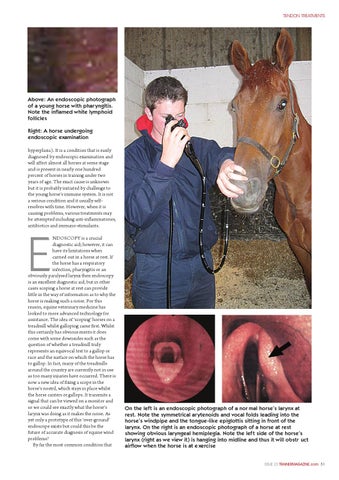The Larynx.qxd:Jerkins feature.qxd
21/8/08
18:14
Page 2
TENDON TREATMENTS
Above: An endoscopic photograph of a young horse with phar yngitis. Note the inflamed white lymphoid follicles Right: A horse undergoing endoscopic examination hyperplasia). It is a condition that is easily diagnosed by endoscopic examination and will affect almost all horses at some stage and is present in nearly one hundred percent of horses in training under two years of age. The exact cause is unknown but it is probably initiated by challenge to the young horse’s immune system. It is not a serious condition and it usually selfresolves with time. However, when it is causing problems, various treatments may be attempted including anti-inflammatories, antibiotics and immuno-stimulants.
E
NDOSCOPY is a crucial diagnostic aid; however, it can have its limitations when carried out in a horse at rest. If the horse has a respiratory infection, pharyngitis or an obviously paralysed larynx then endoscopy is an excellent diagnostic aid, but in other cases scoping a horse at rest can provide little in the way of information as to why the horse is making such a noise. For this reason, equine veterinary medicine has looked to more advanced technology for assistance. The idea of ‘scoping’ horses on a treadmill whilst galloping came first. Whilst this certainly has obvious merits it does come with some downsides such as the question of whether a treadmill truly represents an equivocal test to a gallop or race and the surface on which the horse has to gallop. In fact, many of the treadmills around the country are currently not in use as too many injuries have occurred. There is now a new idea of fixing a scope in the horse’s nostril, which stays in place whilst the horse canters or gallops. It transmits a signal that can be viewed on a monitor and so we could see exactly what the horse’s larynx was doing as it makes the noise. As yet only a prototype of this ‘over-ground’ endoscope exists but could this be the future of accurate diagnosis of equine wind problems? By far the most common condition that
On the left is an endoscopic photograph of a nor mal horse’s larynx at rest. Note the symmetrical ar ytenoids and vocal folds leading into the horse’s windpipe and the tongue-like epiglottis sitting in front of the larynx. On the right is an endoscopic photograph of a horse at rest showing obvious laryngeal hemiplegia. Note the left side of the horse’s larynx (right as we view it) is hanging into midline and thus it will obstr uct airflow when the horse is at e xercise ISSUE 23 TRAINERMAGAZINE.com 51
